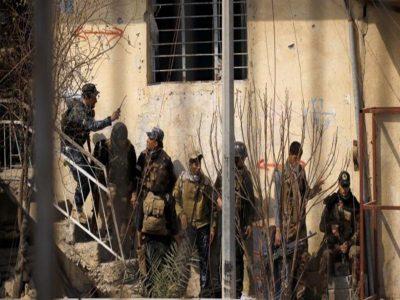
ISIS leader’s top aide killed in the battle for Mosul
Federal Police Forces Commander Lieutenant General Raed Shaker Jawdat said Abu Abdulrahman, identified as the second-in-command of Daesh (ISIL) and a very close aide to its purported leader Abu Bakr al-Baghdadi, was killed on Wednesday after Iraqi troops lobbed a barrage of missiles at a militant position in the Zanjili neighborhood of Western Mosul, the Arabic-language Shafaaq news agency reported.
Jawdat added that his forces also launched a number of rockets at predetermined targets near Omar al-Aswad Mosque in the al-Farouq district of the Old City of Mosul, killing a high-ranking Daesh militant figure and four other Takfiri terrorists. The commander was later identified as Abu Walid al-Tunisi.
The Iraqi army soldiers continued their military operations in Western part of Mosul, hitting hard the positions of the ISIL terrorist group near the historic Great Mosque of al-Nuri.
Commander of the Federal Police Forces Lt. Gen. Raed Shaker Jawdat said Iraqi troops killed over 60 ISIL militants near the historic Great Mosque of al-Nuri.
He added that the Iraqi government forces also destroyed ISIL military hardware and prevented several suicide bombing attacks in the region.
Iraqi government forces have recaptured more lands in the new round of military operation against ISIL militants in Mosul’s Old City in recent days, trying to fully liberate the terrorist group’s last bastion.
“Iraqi forces advanced at least 200 meters deeper into the Old City after they launched their operation on Sunday morning from Qadheeb al-Ban area in Western Mosul,” Jawdat said on Monday.
“Federal police snipers stationed on the roofs of buildings and seized control of the perimeter around the al-Hadba minaret [of the historical Great Mosque of al-Nuri] and targeted the suspicious vehicles and armed persons,” the commander of the federal police added.
Mosul’s al-Nuri mosque is highly symbolic because it was there that leader of the ISIL Takfiri terrorist group, Ibrahim al-Samarrai, also known as Abu Bakr al-Baghdadi, declared himself the so-called caliphate of the terror group, shortly after the flashpoint city fell to terrorists in June 2014 and became their de facto capital in the Arab country.
Iraqi Prime Minister Haider Abadi announced in October 2016, the start of a military operation to recapture Mosul, the second largest city in Iraq which fell to the ISIL since 2014.
The Iraqi defense ministry announced earlier in January that the ISIL terrorist group has lost over 50 percent of its militants in the city of Mosul in Nineveh province as Iraqi troops have managed to recapture the Eastern part of the de facto Capital of the ISIL.
“The intelligence obtained by us indicates that there have been over 6,000 ISIL terrorists in Mosul and around 3,400 of them have been killed in battles with Iraq’s joint military forces in the major city of Nineveh province,” Iraqi Defense Ministry Spokesman Colonel Laith al-Naimi said.
He added that over 250 bomb-laden vehicles and the entire bomb-making workshops of the terrorists have been destroyed in Mosul which means that the ISIL has been paralyzed by the Iraqi forces.
The Iraqi Army started a new phase of its military operation in Nineveh province late February to drive the ISIL terrorists out of their bastion in the Western part of the city of Mosul.
With half the city under the control of Baghdad forces, the Iraqi Armed Forces will likely face heavier resistance in the Western part of Mosul, as the ISIL attempts to hold onto their final positions.
Local sources had disclosed that the ISIL is preventing civilians in the Western part of the city of Mosul from leaving the region in a move to use them as human shields as the terrorist group’s positions are under intensifying attacks by various troops.
Commanders expect the battle in Western Mosul to be more difficult, in part because tanks and armoured vehicles cannot pass through the narrow alleyways that crisscross ancient districts of the city.
Source: /Farsnews





